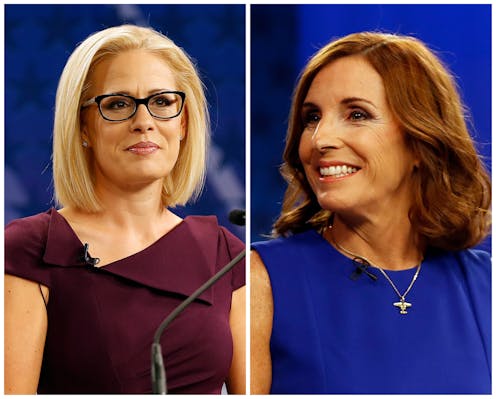Independent voters will decide Arizona's historic female Senate race
- Written by Gina Woodall, Senior Lecturer at the School of Politics and Global Studies, Arizona State University

Throughout most of U.S. history[1], races for the Senate have featured two men.
This year is different. Twenty-two women are running for the U.S. senate[2]. Six senatorial contests feature two women competing against one another.
It’s no surprise that gender is a vital theme in these midterms contests. The #MeToo movement and the contentious Supreme Court hearings of Judge Brett Kavanaugh have emboldened sexual assault victims and advocates for the rights of the accused, social conservatives and progressives – and men and women. But, as we’ve seen here in Arizona, where I study and teach gender and political science[3], these categories are not mutually exclusive.
Republican Martha McSally and Democrat Kyrsten Sinema are running to replace retiring Sen. Jeff Flake in one of the most competitive senatorial races in the country[4].
Both women are highly educated, have previous congressional experience and have been “trailblazers” in their own right. In 1991, McSally became the first woman[5] to fly in combat, and she rose to the rank of colonel in the Air Force before retiring from the military. Sinema[6], who was homelessness for a time as a child, graduated from college at 18 and went on to get her law degree. A Ph.D. and MBA soon followed. She is the first openly bisexual[7] member of Congress.
Whoever wins will be the first female senator from the state of Arizona.
And whoever wins will need independent voters.
That’s because no one party dominates[8] in Arizona. Republicans make up 35 percent of all registered voters. Democrats are 30 percent. And people registered as “other” – the “independent” voters – make up 34 percent of the electorate.
So who are these independents – and are they more likely to back a Republican or a Democrat?
Traditionally, “independent” in Arizona has been code for “Republican.” To paraphrase Daniel Elazer’s classic “American Federalism: A view from the States[9],” Arizonans tend to “buck” traditional norms and established categories while hanging onto conservative principles. More recently however, journalists have noted a trend of independents not leaning toward one party or the other[10].
A recent New York Times poll suggested that the race is a dead heat – with 45 percent planning to vote for each candidate[11]. Just a week before the election, an NBC/Marist poll[12] showed Sinema ahead by 6 points, but the poll at a 5.4 margin of error.
If independents show up at the polls, the race will likely tilt toward Sinema.
If independents stay home, McSally – who was endorsed by President Trump[13] and even received an enthusiastic presidential tweet[14] – will likely win.
To me, one interesting wild card in the race is the Kavanaugh hearings.
When asked how she would have voted on Kavanaugh’s nomination during the race’s one debate, McSally offered a nuanced response: “I would’ve voted yes. I’m a survivor of sexual abuse. [Professor Ford] has been through trauma, [but] Arizona wanted a ‘yes’ vote. I can be for survivors, as [I was] one myself, and for Judge Kavanaugh.”
Sinema noted that she wouldn’t vote for Judge Kavanaugh, but didn’t speak to the issue with the same passion as McSally.
The debate point may have gone to McSally, but how the issue may impact voters is less clear.
A CBS poll (conducted by YouGOV)[15] showed Arizona voters were split on Kavanaugh, with 41 percent supporting and 39 percent opposing his confirmation. The same poll suggested that among likely Arizona voters who said they might still change their mind about whom to support, 30 percent said Kavanaugh’s confirmation would make them more likely to consider voting for a Democrat, while only 10 percent said the same for a Republican.
Independents have enormous power to decide this race in Arizona.
And the dynamics of the race may soon become more familiar as generations that tended to identify with one of the major political parties are replaced by those who see themselves as independents[16].
References
- ^ Throughout most of U.S. history (www.nytimes.com)
- ^ women are running for the U.S. senate (www.cnn.com)
- ^ I study and teach gender and political science (scholar.google.com)
- ^ the most competitive senatorial races in the country (www.cookpolitical.com)
- ^ McSally became the first woman (mcsally.house.gov)
- ^ Sinema (sinema.house.gov)
- ^ openly bisexual (www.advocate.com)
- ^ no one party dominates (azsos.gov)
- ^ “American Federalism: A view from the States (www.worldcat.org)
- ^ not leaning toward one party or the other (www.pbs.org)
- ^ the race is a dead heat – with 45 percent planning to vote for each candidate (www.nytimes.com)
- ^ NBC/Marist poll (www.cnbc.com)
- ^ who was endorsed by President Trump (www.azcentral.com)
- ^ enthusiastic presidential tweet (www.washingtonexaminer.com)
- ^ CBS poll (conducted by YouGOV) (www.vox.com)
- ^ those who see themselves as independents (www.people-press.org)
Authors: Gina Woodall, Senior Lecturer at the School of Politics and Global Studies, Arizona State University

